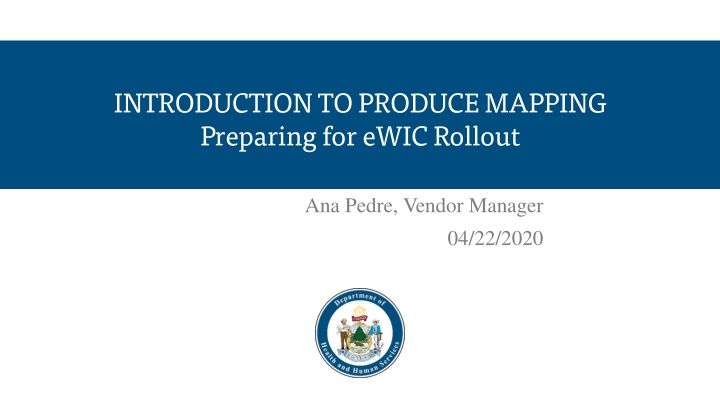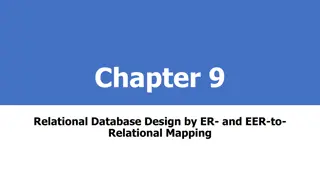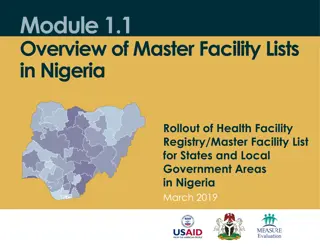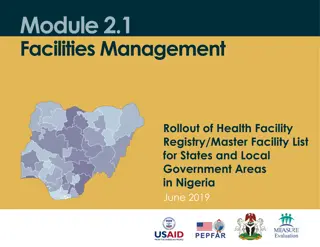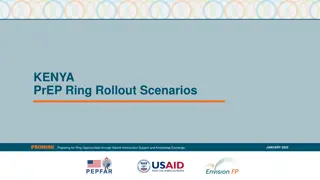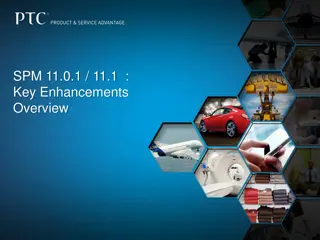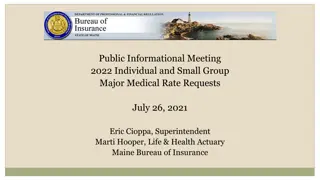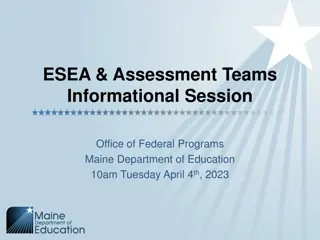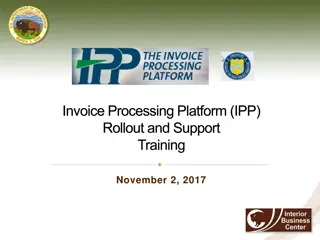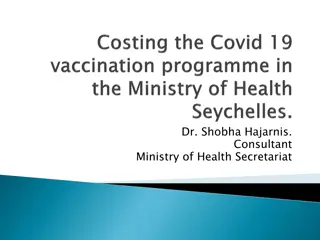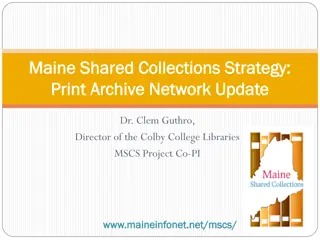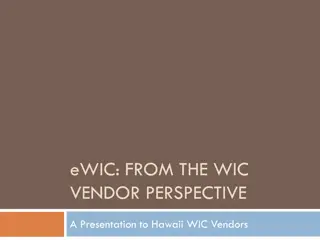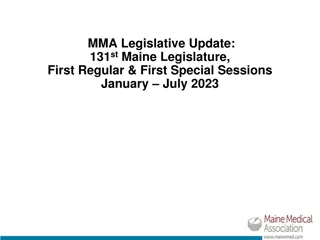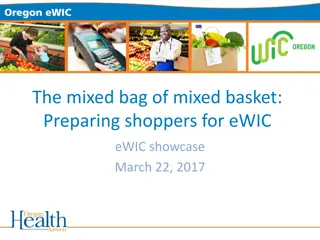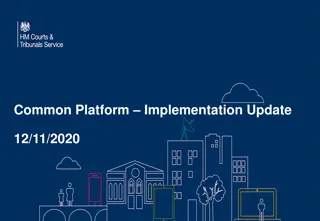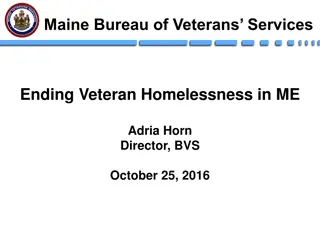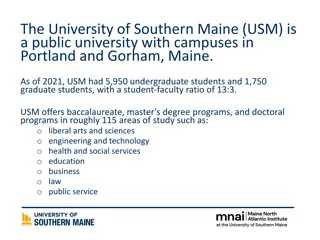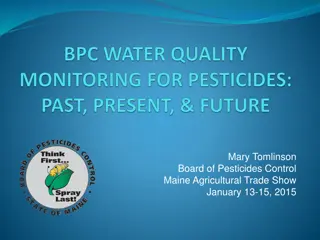Maine eWIC Rollout: Introduction to Produce Mapping
Prepare for the eWIC rollout in Maine by understanding the importance of produce mapping, submitting UPCs for approval, and ensuring items are on the approved product list. Learn how eWIC streamlines transactions and offers flexibility to participants.
Download Presentation

Please find below an Image/Link to download the presentation.
The content on the website is provided AS IS for your information and personal use only. It may not be sold, licensed, or shared on other websites without obtaining consent from the author.If you encounter any issues during the download, it is possible that the publisher has removed the file from their server.
You are allowed to download the files provided on this website for personal or commercial use, subject to the condition that they are used lawfully. All files are the property of their respective owners.
The content on the website is provided AS IS for your information and personal use only. It may not be sold, licensed, or shared on other websites without obtaining consent from the author.
E N D
Presentation Transcript
INTRODUCTION TO PRODUCE MAPPING Preparing for eWIC Rollout Ana Pedre, Vendor Manager 04/22/2020
Maine INTRODUCTION TO PRODUCE MAPPING 1 Preparing for eWIC Rollout 1 Disclaimer: This document is provided as an introduction to produce mapping. Vendors need to contact their Value Added Reseller (VAR) and Point of Sale Provider (POS) for details on how to complete produce mapping for their specific system.
Maines Approved Product List (APL) A list of all the Maine WIC approved food benefits including fruits and vegetables Maine s APL has over 25,000 UPC s and PLU s. The APL is a work in progress and Vendors will be able to continue to submit UPC s through the normal methods. These include Email, WICShopper app and Online Form Submission. For many reasons including seasonal items, repackaging, multiple vendors, etc., not all fruit and vegetable UPC s will be listed on the APL.
Produce UPCs and PLUs The Maine Approved Product List (APL) contains: Close to 2600 produce Price Look Up (PLU) codes from International Fresh Produce Standard (IFPS) list (4 5 digit codes on loose and bundled produce) Hundreds of packaged produce UPCs (i.e., bagged lettuce) Some vendors may use non-standard PLUs or may generate their own UPCs for produce packaged in the store these items must be mapped 4
But This Item Should Be WIC Approved? Any item thought to be WIC-eligible that is not a fresh fruit/vegetable item should be submitted to Maine WIC, who will evaluate whether it should be added to the APL. FAQs: Q: Who reports items for APL consideration? A. Anyone can submit a UPC for consideration. Q: How do I submit items for APL consideration? A. UPC s can be submitted through the usual channels: Email SubmitUPCWIC@maine.gov ., WICShopper app & Online Submission Form. Q: After I submit items for the APL, how long until they are added? A. The decision timeframe is varied because of the many factors that are reviewed when making this determination.
Maines Approved Product List Why Is This Important? During an eWIC transaction, your POS confirms if benefits are available for redemption and if the food benefit item is on the approved product list. The good news is that with eWIC, if an item does not ring up, the participant can have the item removed from their order, and it will remain available on their account balance next time they go shopping. This is an improvement from the world of WIC checks, where everything on a check has to be redeemed during that store visit.
Which Brings Us To: Introduction To Produce Mapping Produce Mapping is a functionality of your integrated Point of Sale (POS) software that allows you to link a UPC to a PLU listed in the Maine WIC Approved Product List (APL). Maine WIC requires full or one-to-one mapping, which means that a fresh produce item with a UPC must be mapped to a PLU for the same kind of item. For example, cut up watermelon with a UPC would be mapped to a PLU for bulk watermelon. Full Mapping: The item is mapped to a produce specific IFPS PLU code that identifies the fruit or vegetable by name and type; i.e., banana, red delicious apple, eggplant, yellow onion, etc. Some vendors may use non-standard PLUs or may generate their own UPCs for produce packaged in the store these items must be mapped. 7
Why Is Produce Mapping Necessary? There are several reasons why it s necessary to map WIC allowed UPC dproduce to a like PLU. First, it s very difficult for Maine WIC to keep track of all the different produce UPCs, so retailers can make sure that all WIC allowed produce can be purchased with a WIC card by mapping the UPCs. It can take many days for any new UPC to be added to the APL, which might be too slow for some seasonal items. Retailers can allow a produce item for sale much faster if they map the UPC. Some of these UPCs are regional or retailer-generated, and cannot be added to the APL. 8
Who Completes Mapping For A Store? In corporately owned stores, the mapping may be completed at the corporate office. In independent or decentralized stores, mapping is typically completed at store level. Who? Internally, it is often produce managers in the store who are responsible for this task on an ongoing basis. Who can help me with mapping? Your POS provider is responsible for providing instructions on produce mapping. The Maine WIC staff can tell you if an item needs to be mapped, but are not equipped to help with the process. Who? Stores will need to work with their Value-Added Resellers (VARs) about the details of how to map items in their particular POS system. Solutran, Maine s eWIC Service Provider, may also be a resource for high-level questions about mapping. 9
What must be mapped? Stores will need to map any fresh fruit and vegetable items that are not in the APL. Non-standard PLUs: Any produce codes that do not comply with the IFPS list. These may be codes created by the store or by a the seller of the produce. Store generated UPCs/UPCs starting with 2, 4 and 9: Bar codes printed in the store typically for store packaged items like cut fruit or vegetable assortments. 10
F AQs About Mapping Q: I work for a store whose wholesaler has 23 PLUs for red seedless grapes, are you working with the growers to attain their PLUs? A: No, we only get our PLUs from the IFPS (International Federation for Produce Standards) website. That is our governing body over PLUs because they have to be unique, so the products have to go through the process. If a store gets a PLU that is not a standard PLU then it needs to be mapped to an approved IFPS PLU. Q: Will we have to provide our PLU codes? A: The only PLUs that we can take are those from the national IFPS. The system won t let any other PLUs be entered. Those items will need to be mapped to the standard PLU (from IFPS), and then the state will approve. Q: How do I map store-packaged variety packs of fruit or vegetables? (i.e.Cut- up honeydew and cantaloupe) A: It is acceptable to map mixed containers to a PLU of one (1) item in the container. Link to IFPS website: http://www .ifpsglobal.com/Identification/PLU-Codes 11
Questions? Ana Pedre, Vender Manager WICVendor.DHHSMECDC@maine.gov (207) 287-3991 12 Maine Department of Health and Human Services Center for Disease Control and Prevention
